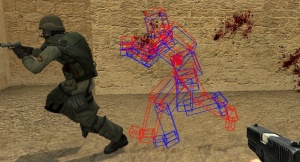Lag Compensation
- You may be looking for Yahn Bernier's 2001 paper on game engine networking.
Lag compensation is the notion of the server using a player's latency to rewind time when processing a usercmd, in order to see what the player saw when the command was sent. In combination with prediction, lag compensation can help to combat network latency to the point of almost eliminating it from the perspective of an attacker. For a more detailed explanation, see the Source Multiplayer Networking article.
By default only players are rewound, and one second of location/animation history is kept.
LagCompensate !FGD keyvalue, this feature is also in Configuration
| Cvar/Command | Parameters or default value | Descriptor | Effect |
|---|---|---|---|
| cl_lagcompensation | bool | Allows clients to tell the server that they don't want their own commands lag compensated. This is not a cheat. | |
| cl_lagcomp_errorcheck | int | Deprecated? In theory displays error information for the given player index, in practice is not referenced anywhere. | |
| sv_lagcompensationforcerestore | bool | Cheat. Disabling this causes the game to check if each entity can still occupy its rewind position in the current, un-rewound world. If it can't, it is rewound to the last valid position instead of the desired one. Todo: Why would anyone want that to happen? |
|
| sv_showlagcompensation | bool | Cheat. Displays rewound hitboxes whenever a player is lag compensated. This fills the role of the old sv_showhitboxes command, only without the confusion caused by the hitboxes also being shown when compensation is not in effect. |
Developer server builds (those compiled with ALLOW_DEVELOPMENT_CVARS), or by using server plugins such as SourceMod (to enable hidden console commands) have some extra commands:
| Cvar/Command | Parameters or default value | Descriptor | Effect |
|---|---|---|---|
| sv_unlag | bool | Enable/disable lag compensation entirely. | |
| sv_maxunlag | float | Number of seconds to store player positions for. Default (and maximum) is 1. |
Invocation
Simply wrap whatever code you want lag compensated within two calls to the lagcompensation object:
#ifdef GAME_DLL
#include "..\server\ilagcompensationmanager.h"
void CMyPlayer::FireBullets ( const FireBulletsInfo_t &info )
{
// Source 2007
lagcompensation->StartLagCompensation( this, this->GetCurrentCommand() );
// Alien Swarm and later (See also sub-section below)
lagcompensation->StartLagCompensation( this, LAG_COMPENSATE_HITBOXES );
BaseClass::FireBullets(info);
lagcompensation->FinishLagCompensation( this );
}
#endif
Time will be wound back on the call to StartLagCompensation(), and wound forward again on the call to FinishLagCompensation().
Lag Compensation Type
Starting with Alien Swarm, you can optimise lag compensation with these settings:
LAG_COMPENSATE_BOUNDS- Rewind entities' locations only, skipping animations.
LAG_COMPENSATE_HITBOXES- Rewind both locations and hitboxes. This is the standard setting.
LAG_COMPENSATE_HITBOXES_ALONG_RAY- Rewind hitboxes if an entity is hit by a ray defined by the "weaponPos"
StartLagCompensation()overload. Otherwise rewind bounds only.
These setting chosen applies to all entities affected by the rewind.
